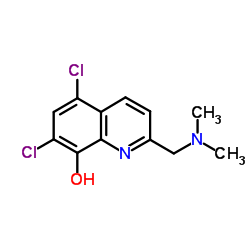747408-78-2
| Name | PBT-1033 |
|---|---|
| Synonyms |
5,7-Dichloro-2-[(dimethylamino)methyl]-8-quinolinol
Q7K6GJQ4O4 PBT-1033 MFCD30749371 |
| Description | PBT 1033 (PBT 2) is an orally active copper/zinc ionophore. PBT 1033 restores cognition in mouse models of Alzheimer's disease (AD). PB 1033 also has antibacterial activity against Gram-positive bacteria[1][2]. |
|---|---|
| Related Catalog | |
| In Vitro | PB 1033 displays antibacterial activity against S. uberis, with a MIC value of 14.5 μM[2]. PBT2 (1, 3 and 7.5 μM, 6 h) protects neurons against glutamate-induced excitotoxicity[3]. PBT2 (10 μM, 1 or 6 h) reduces NMDAR-mediated Ca2+ flux in mouse cortical neurons[3]. PBT2 (0-10 μM, 1 h) increases GSK3α/β phosphorylation in SH-SY5Y cells[4]. PBT2 (20 μM, 1 h) prevents the formation of Zn-induced protease resistant Aβ aggregates[5]. Western Blot Analysis[4] Cell Line: SH-SY5Y cells Concentration: 0-10 μM Incubation Time: 1 h Result: Increased in cellular levels of GSK3α/β phosphorylated at the inhibitory serine 21/9 residue (ser21/9 on GSK3α/β). |
| In Vivo | PBT 1033 (30 mg/kg/d, p.o., 11 days) restores biochemical substrates of learning/memory in a mouse model of alzheimer's disease[5]. Animal Model: Female Tg2576 mice[5] Dosage: 30 mg/kg/d Administration: Oral administration, 11 days Result: Increased hippocampal apical spine density, basal spine density. |
| Density | 1.4±0.1 g/cm3 |
|---|---|
| Boiling Point | 367.8±37.0 °C at 760 mmHg |
| Molecular Formula | C12H12Cl2N2O |
| Molecular Weight | 271.142 |
| Flash Point | 176.2±26.5 °C |
| Exact Mass | 270.032654 |
| LogP | 3.51 |
| Vapour Pressure | 0.0±0.9 mmHg at 25°C |
| Index of Refraction | 1.654 |
